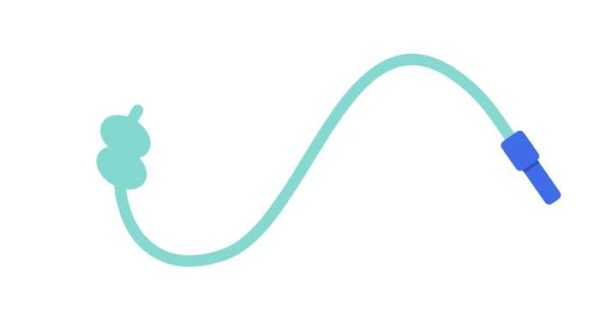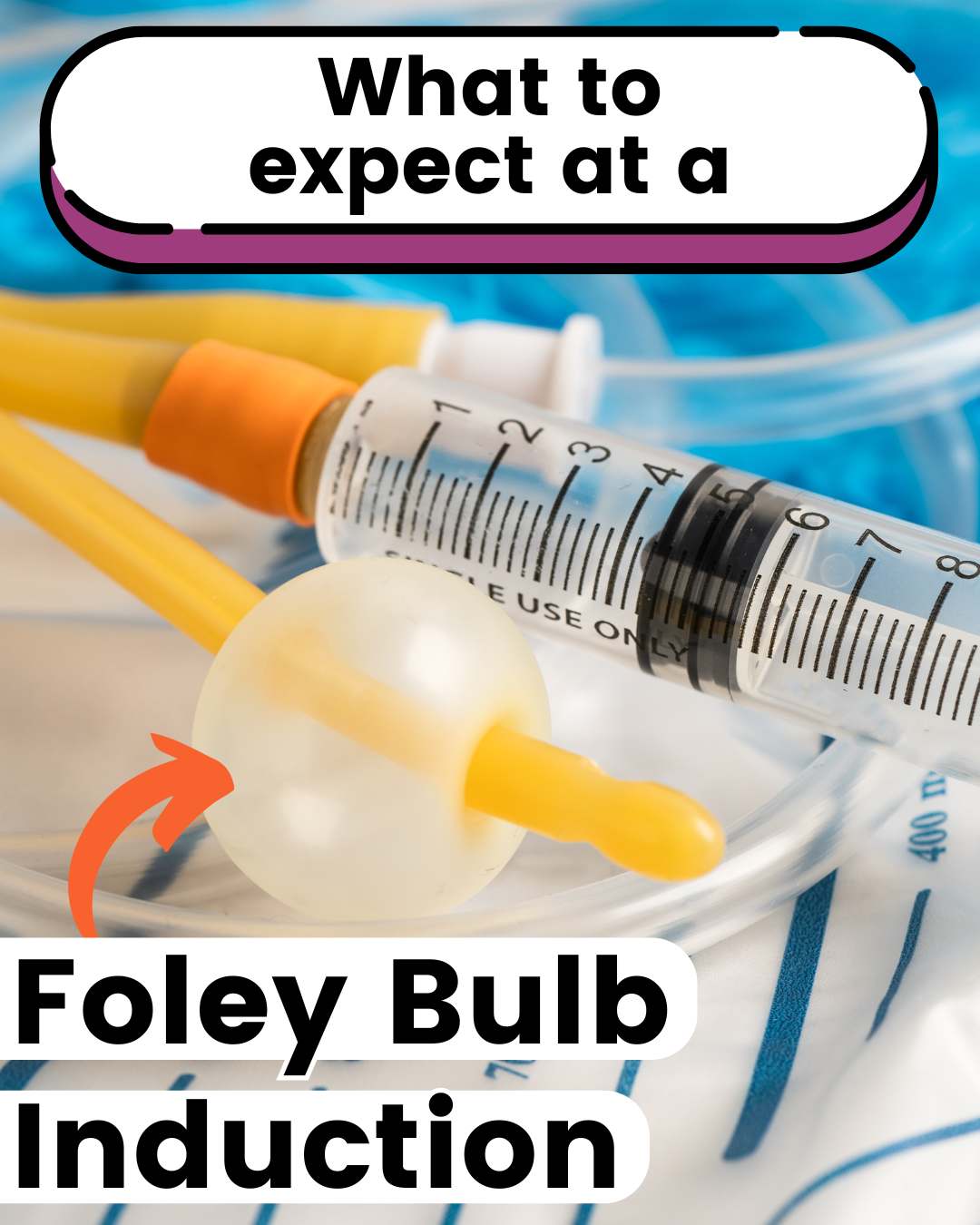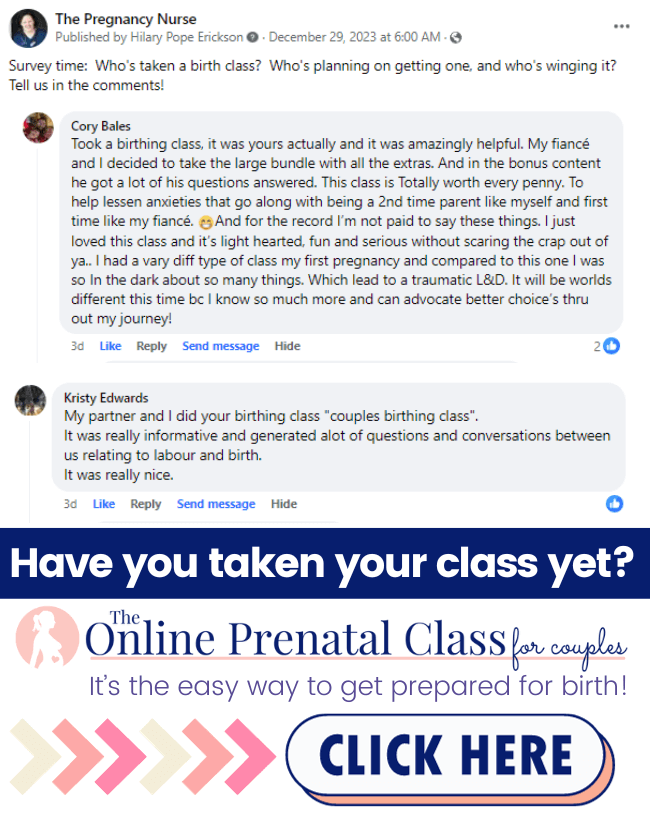👋 I’m so glad YOU are here. Are you looking to also get your partner prepared? This is for BOTH of you. Couples just love it and I know you want to both feel prepared!
Has your doctor said they will place a foley bulb with your induction? What does that mean, what does it look/feel like and what you should you plan for at the hospital (or when you go home). Let’s talk about it.
Before we get going, understanding your induction is PARAMOUNT for being induced. Grab my induction questions right here (they’ll help make sure you know what to expect before it. The length & pain of inductions catch FAR TOO MANY patients off-guard).
How Does a Foley Bulb Induction Work?
It varies a bit by facility, but the basics (and a few options) are:
They will place a foley catheter balloon in your cervix. Often it looks like this (I photoshopped this baby together). You see the “groove” in the middle of the two ovals, that’s what will go in your cervix.

That place it when it is not “full” (so just a tube) and then we place sterile saline in it that blows-up those balloons.
The idea is that this sort of “cranks” your cervix open manually.
Some places place just a regular foley balloon in the middle. Most depends on what is available.

This balloon is then left to hang out in there and stretch that cervix. At this point there’s a couple of options.
Some providers place “traction” on it (more necessary when it’s a regular Foley balloon vs the cook’s) — either stretched a bit and taped to your leg, or some have an IV bag placed on the end. I’ve heard studies on this are mixed as to if it helps vs just the pressure of the balloon.
I actually just read a study on how patients can self-perform the traction on the foley according to their pain tolerance and wishes — I thought that was really cool (and it says that traction does increase dilation and decreases the amount you need it in). Patient felt more control and happier with their induction. Read the study here.
Some providers may start induction medication at the same time:
- Low dose pitocin
- Cytotec/Misoprostil
Most often it depends on what’s going on for you.
Some providers even place the foley bulb in the office prior to a medication induction and let you go home with it in until the next day or whatever (usually only done if you aren’t getting medication in addition).
Want more information on inductions, check out these posts:
- Your Myth-Busting Guide to Induction
- Navigating Induction: Empowering Choice and Educating Yourself with Dr Elizabeth
- What Happens If Your Induction Doesn’t Work?
- How To Prepare For An Induction
- How Long Does An Induction Of Labor Take?
How long will it take?
It should make the induction shorter than it would have been without it (see the studies below) — but it depends more on the ripeness of your cervix and how well your body responds to all of it, more than anything else.
However, your provider should have an idea (frankly, just a good guess) — which is part of my induction question checklist:
How exactly do they do it?
They use an instrument to push the tip into your cervix. Some providers use a speculum to visualize the cervix to do this (some just do it by feeling).
Then, once the balloon is in the proper place, they fill it with a certain amount of water.

Are there risks to it?
As with anything in the hospital, there are always risks. It’s similar to a membrane sweep, so there’s a chance of infection and also the possibility of breaking your water while they are inserting it.
However, risks vary — so be sure to ask your provider what the risks are for YOU.
Want to learn more about things you should learn risks and benefits for — check-out these articles:
- Considering A VBAC: What To Do
- Should You Let Your Provider Break Your Water?
- Epidurals During Pregnancy & Labor
- Can You Refuse A Urinary Catheter During Labor
- Tips To Saying No To Your Provider
And now, the biggest question I get:
How much does a Foley bulb induction hurt?
GREAT question, and I’m here to say this REALLY varies. Some people don’t have an issue with it at all, and some find it VERY painful.
I tend to see a lot of that depends on the skill of your provider (if they get it in the right place), your cervix and managing exams in general.
I have heard that many facilities offer pain medication via IV when you’re getting it placed.
The good news, you could always try to get it placed without IV meds, and then ask for the IV meds if it’s too much. They work pretty quickly. The ones I’ve heard offered were Fentanyl and Morphine in case you’re wondering.
Those are likely to make you pretty sleepy too, so just go with it.
In my experience, the people with the most pain tend to happen when the practitioner has it in the wrong spot. If you’re having severe pain make sure you’re speaking up so it’s done correctly!
The other good news is that it’s not a long procedure. So, if you’re able to breathe and relax for just a few minutes it’s done.
I recommend everyone have some natural pain management techniques, and I also know every patient needs to know how to navigate choices at the hospital. If you’re having an induction you will definitely need both of those things. The Online Prenatal Class for couples provides both!

What happens then?
The doctor will leave the foley bulb in for a prescribed amount of time, or may choose to remove it at some point.
OR, it falls out on it’s own once your cervix is dilated. The foley bulb alone can only get you to about 3 cm (because that’s how big it is).
What happens then is a SUPER common question in labor and delivery, and SO normal to wonder that. Which is why I created this.
What do studies show?
Great question, I think that’s important.
This study showed that the Foley bulb plus some misoprostol worked better than misoprostol alone.
This study showed that getting the Foley bulb prior to coming to the hospital to be induced showed that it took less time from admission to induction.

Tips for Placement
There are things you can do to make the placement easier.
The biggest one is to relax. The more your tighten-up with the pain, the worse it makes it (and makes it harder for them to place). Check out my post on painful cervical exams for more ideas there (including one you probably won’t think of).
If you find you’re not able to relax I’d ask them if there’s any medication you can take.
Pro Tip: Ask your provider if there’s something you could take about 30 minutes before placement. Some may recommend oral meds.
I am a HUGE fan of learning to relax your pelvic floor. Breathing can be REALLY helpful as it’s hard to tense up when you’re concentrating on breathing. My natural pain managment bonus video in here is SO helpful for it.
You may be thinking that an article or two, and you’re good to go but I can’t say any more strongly that EVERY couple needs to take a prenatal class that prepares you from pregnancy through your postpartum life. It’s not just about pain management, it’s about making choices for yourself. You need to know how to do that, especially if you’re going in for an induction.
Anyway — that’s a soapbox of mine. I hope you have an amazing induction, and this article gave you a bit more on what to expect on your special day. 🙂
Sources:
- Ausbeck, Elizabeth B. MD; Jauk, Victoria C. MPH; Xue, Yumo MS; Files, Pamela BSN, ANP; Kuper, Spencer G. MD; Subramaniam, Akila MD, MPH; Casey, Brian M. MD; Szychowski, Jeff M. PhD; Harper, Lorie M. MD, MSCI; Tita, Alan T. MD, PhD. Outpatient Foley Catheter for Induction of Labor in Nulliparous Women: A Randomized Controlled Trial. Obstetrics & Gynecology 136(3):p 597-606, September 2020. | DOI: 10.1097/AOG.0000000000004041
- Anjali, Jain S, Pasrija S, Kille HC. Labor induction with combined low-dose oral misoprostol and Foley catheter vs oral misoprostol alone at term gestation-a randomized study. AJOG Glob Rep. 2022 Jun 11;2(3):100060. doi: 10.1016/j.xagr.2022.100060. PMID: 36276789; PMCID: PMC9563989.










 Sleeping During Pregnancy: Tips by Trimester
Sleeping During Pregnancy: Tips by Trimester
